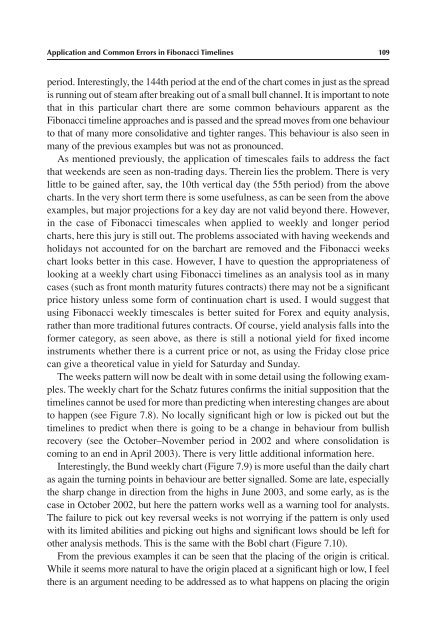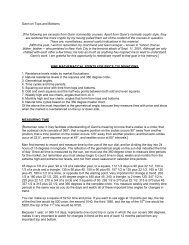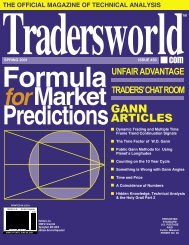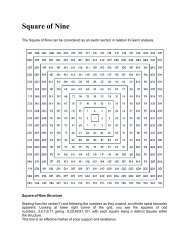Fibonacci and Gann Applications in Financial Markets
Fibonacci and Gann Applications in Financial Markets
Fibonacci and Gann Applications in Financial Markets
You also want an ePaper? Increase the reach of your titles
YUMPU automatically turns print PDFs into web optimized ePapers that Google loves.
Application <strong>and</strong> Common Errors <strong>in</strong> <strong>Fibonacci</strong> Timel<strong>in</strong>es 109<br />
period. Interest<strong>in</strong>gly, the 144th period at the end of the chart comes <strong>in</strong> just as the spread<br />
is runn<strong>in</strong>g out of steam after break<strong>in</strong>g out of a small bull channel. It is important to note<br />
that <strong>in</strong> this particular chart there are some common behaviours apparent as the<br />
<strong>Fibonacci</strong> timel<strong>in</strong>e approaches <strong>and</strong> is passed <strong>and</strong> the spread moves from one behaviour<br />
to that of many more consolidative <strong>and</strong> tighter ranges. This behaviour is also seen <strong>in</strong><br />
many of the previous examples but was not as pronounced.<br />
As mentioned previously, the application of timescales fails to address the fact<br />
that weekends are seen as non-trad<strong>in</strong>g days. There<strong>in</strong> lies the problem. There is very<br />
little to be ga<strong>in</strong>ed after, say, the 10th vertical day (the 55th period) from the above<br />
charts. In the very short term there is some usefulness, as can be seen from the above<br />
examples, but major projections for a key day are not valid beyond there. However,<br />
<strong>in</strong> the case of <strong>Fibonacci</strong> timescales when applied to weekly <strong>and</strong> longer period<br />
charts, here this jury is still out. The problems associated with hav<strong>in</strong>g weekends <strong>and</strong><br />
holidays not accounted for on the barchart are removed <strong>and</strong> the <strong>Fibonacci</strong> weeks<br />
chart looks better <strong>in</strong> this case. However, I have to question the appropriateness of<br />
look<strong>in</strong>g at a weekly chart us<strong>in</strong>g <strong>Fibonacci</strong> timel<strong>in</strong>es as an analysis tool as <strong>in</strong> many<br />
cases (such as front month maturity futures contracts) there may not be a significant<br />
price history unless some form of cont<strong>in</strong>uation chart is used. I would suggest that<br />
us<strong>in</strong>g <strong>Fibonacci</strong> weekly timescales is better suited for Forex <strong>and</strong> equity analysis,<br />
rather than more traditional futures contracts. Of course, yield analysis falls <strong>in</strong>to the<br />
former category, as seen above, as there is still a notional yield for fixed <strong>in</strong>come<br />
<strong>in</strong>struments whether there is a current price or not, as us<strong>in</strong>g the Friday close price<br />
can give a theoretical value <strong>in</strong> yield for Saturday <strong>and</strong> Sunday.<br />
The weeks pattern will now be dealt with <strong>in</strong> some detail us<strong>in</strong>g the follow<strong>in</strong>g examples.<br />
The weekly chart for the Schatz futures confirms the <strong>in</strong>itial supposition that the<br />
timel<strong>in</strong>es cannot be used for more than predict<strong>in</strong>g when <strong>in</strong>terest<strong>in</strong>g changes are about<br />
to happen (see Figure 7.8). No locally significant high or low is picked out but the<br />
timel<strong>in</strong>es to predict when there is go<strong>in</strong>g to be a change <strong>in</strong> behaviour from bullish<br />
recovery (see the October–November period <strong>in</strong> 2002 <strong>and</strong> where consolidation is<br />
com<strong>in</strong>g to an end <strong>in</strong> April 2003). There is very little additional <strong>in</strong>formation here.<br />
Interest<strong>in</strong>gly, the Bund weekly chart (Figure 7.9) is more useful than the daily chart<br />
as aga<strong>in</strong> the turn<strong>in</strong>g po<strong>in</strong>ts <strong>in</strong> behaviour are better signalled. Some are late, especially<br />
the sharp change <strong>in</strong> direction from the highs <strong>in</strong> June 2003, <strong>and</strong> some early, as is the<br />
case <strong>in</strong> October 2002, but here the pattern works well as a warn<strong>in</strong>g tool for analysts.<br />
The failure to pick out key reversal weeks is not worry<strong>in</strong>g if the pattern is only used<br />
with its limited abilities <strong>and</strong> pick<strong>in</strong>g out highs <strong>and</strong> significant lows should be left for<br />
other analysis methods. This is the same with the Bobl chart (Figure 7.10).<br />
From the previous examples it can be seen that the plac<strong>in</strong>g of the orig<strong>in</strong> is critical.<br />
While it seems more natural to have the orig<strong>in</strong> placed at a significant high or low, I feel<br />
there is an argument need<strong>in</strong>g to be addressed as to what happens on plac<strong>in</strong>g the orig<strong>in</strong>






